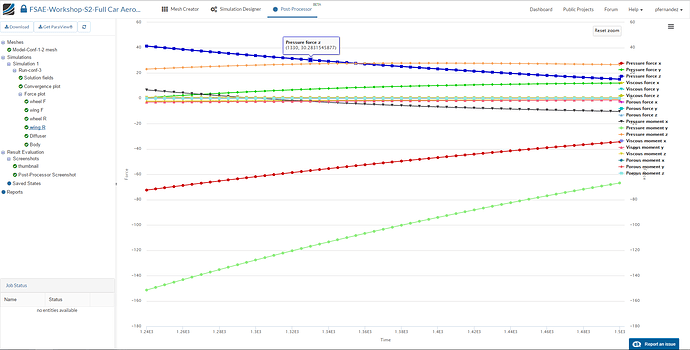Here is a link to my project so it can be reviewed
https://www.simscale.com/workbench?publiclink=73c3c691-0807-44fd-a47a-c544d105c31a
@ahmedhussain18
I did the second homework with this step by step tutorial: Step-by-Step Tutorial: Homework of Session 2
It contains 3 simulations (static wheels, rotating wheels and rotating MRF wheels).
If it’s right that I just have to do the third simulation, ignore the first two simulations and have a look on the third. I still have the problem I mentioned.
Thanks
Philipp Biedenkopf
Hi @varunsura, @fhnx, @LoganZundel
Your solutions are not fully converged. You’ll need to run about 6000 iterations in order to get an acceptable solution.
If you take a look at any of the force results, you’ll see that there are still strong variations.
The more iterations you run, the longer it takes. As this is an exercise, I wouldn’t care too much, because you are saving computation quota while getting a broad idea of the workflow in SimScale. For your actual FS car, I would make sure to reach convergence before “trusting” any results.
Cheers.
I started the meshing of the model and it failes giving me the following errors
“Illegal triangles were found after surface tesselation. There could be a problem with the CAD geometry. Trying to proceed anyway.”
“The tesselated surface is not closed. There could be a problem with the CAD geometry (such as self-intersections). Please inspect your geometry. Trying to proceed anyway.”
I have exactly the same problem. I tried to restart the meshing and now it’s working but it took a lot of time.
Hi,
I have some problems doing the mesh.
In the meshing log I got the error: (25): ERROR: dgraphFold2: out of memory (2)
What does this mean?
The link of my project is https://www.simscale.com/workbench?publiclink=5f9f4073-425c-48fc-8203-32d3431562f6
Thank you for your help!
I am having this problem during the run of the simulation
The job execution was aborted, possibly due to a numerical instability. Review the log to identify reasons: unphysically large field values, extremely small time step size, etc. Modifying numerical settings and time step size could resolve the issue.
May somebody help me?
in new refinement operation the system has error: “Could not create new mesh refinement.”
Hi @melia,
Have you tried with the latest version of the geometry? If you are not sure, Import the Homework Project again from the link in the first post. I had no issues with the STL.
Cheers.
Hey!
I’ve had the same problem as @varunsura @fhnx @LoganZundel However, I checked on the convergence plots as you suggested. My results seemed to have converged. Any further suggestions?
My project for review:
Hi,
your sim did not converge. You have to zoom in on the graphs to get rid of the big deviations from the beginning.
I can’t find the 3rd confi model in the imported file. Do we have to complete only one model i.e.1-2 confi?
Oh ok. Thanks!
After adding second slice i am unable to see complete rear tyre. In the first slice also i have to change middle value of origin to 0.002.
Can anyone suggest me how to rectify it?
Here is my project link
Deselect the eye on Slice 1. You should be able to see Slice 2 properly. Try not changing the origin coordinates. Those are CAD inputs.
Okay thanks got it!
@vkrause I have the same error. Rechecked all the parameters and they seem correct, did you find a solution for the error ?
thank you, i import the homework project again but in mesh operation , i got the error: “Job ‘Operation 1’ failed”
I get this error when i try to run my simulation but I double checked my boundary conditions and the surfaces selected and there is nothing different to the ones specified in the step by step tutorial. Can someone please help me?
“Probably a wall function boundary condition has been assigned to the bounding face of a MRF zone. Please check your boundary conditions and make sure that no boundary conditions are defined on the bounding faces of the MRF zones.”
